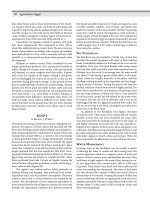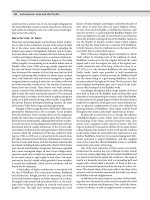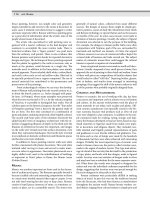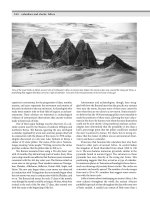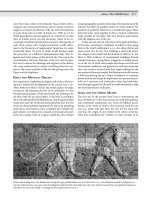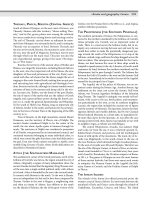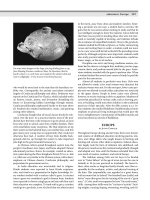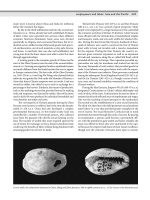Encyclopedia of society and culture in the ancient world ( PDFDrive ) 285
Bạn đang xem bản rút gọn của tài liệu. Xem và tải ngay bản đầy đủ của tài liệu tại đây (69.2 KB, 1 trang )
256
climate and geography: Greece
complete. Once the most fertile lands were colonized, farming spread to poorer quality soil, which the invention of the
plow made it possible to cultivate.
DEFORESTATION
The most visible effect of cultivation and stockherding was
the cutting of the forest for fields, pastures, construction material, and firewood. This deforestation appears in the pollen record as a dramatic and unnatural drop in the amount
of tree pollen and a simultaneous increase in the amount
of grass pollen. The ribwort plantain (Plantago lanceolata)
flourishes in pastures, and its abundance in pollen samples
from 4000 b.c.e. onward across temperate Europe reflects
the high degree of deforestation. Deforestation in turn promoted soil erosion. When the climate turned wetter around
500 b.c.e., increased sediment deposition, or alluviation, occurred in valleys.
BLANKET BOG FORMATION
In Ireland and parts of Britain the removal of the forests by
early farmers caused soil nutrients to be washed away, making the soils more acidic. Heather and rushes grew on the acid
soils, and in areas of poor drainage the acidity inhibited the
decomposition of dead vegetation, which formed peat. Layer
upon layer of peat accumulated over the next several millennia, burying entire landscapes. The field walls and house remains of early farmers at the Céide Fields in northern County
Mayo in Ireland that date to 3500 b.c.e. were subsequently
covered by blanket bog over the last 5,000 years, preserving
them for archaeologists.
During the later part of European prehistory, resources
that had very localized sources came into widespread demand. Key among these were metal ores, especially the copper and tin needed to make bronze, which came into use
around 2500 b.c.e. Copper comes from sources in the Balkans, the Alps, Wales, and southwestern Ireland, while tin
has a much more limited distribution. Cornwall and Iberia
were most often mentioned as its sources. Since copper and
tin have to be smelted together to make bronze, it was necessary for people to mine the ores and then transport them to
the same location.
Gold was extracted from placer deposits in streams and
then hammered to make ornaments. The goldwork of the
Late Neolithic in southeastern Europe, most notably found at
the Varna cemetery, and of the Bronze Age in Ireland, is truly
remarkable. Even more noteworthy is that much of it was deliberately buried in graves or in ritual deposits in bogs.
Later in prehistory, around 800 b.c.e., iron came into
widespread use, though bronze continued to be used extensively. Iron ores are more widely distributed and easily mined,
but smelting the iron from its ore requires high temperatures
and the addition of carbon and limestone to the furnace to
complete the chemical reaction. Iron manufacture was thus
technically more advanced than bronze production, despite
the fact that the raw material is easier to obtain.
Another commodity that was widely in demand in prehistoric Europe was salt, which was used for food preservation. Along the coasts and near salt springs, salt was produced
through evaporation. When prehistoric people found deposits
of rock salt, they mined them. Some of the most famous Iron
Age salt mines, dating between about 800 and 500 b.c.e., are
found at Hallstatt, near Salzburg in Austria. The shafts and
tunnels of the Hallstatt mines reached deep into the mountain, and artifacts found nearby reflect trade networks that
stretched from the Baltic to the Mediterranean.
Among the materials obtained in exchange were amber
from the Baltic and coral from the Mediterranean. Amber is
fossilized pine resin, and it is still abundant along the coasts
of Poland and Lithuania even today. Another Mediterranean
substance highly desired by the Iron Age chiefs of central Europe was wine, for grape cultivation and fermentation had
become major agricultural activities in the warmer parts of
Europe by the last millennium b.c.e.
The demand for copper, tin, salt, gold, amber, and coral
as well as agricultural products, tools, and weapons led to the
establishment of regular trade routes. Wagons pulled by oxen
and horses, and large watercraft that could cross open bodies of water, were crucial in sustaining the trade connections
between the communities of prehistoric Europe. Large boats
built from planks, like the one discovered near Dover in 1992,
crossed between the continent and the British Isles. Along
with the goods, people and ideas also moved.
Such was the world that the Romans encountered when
they extended their empire into temperate Europe. The Roman historian Tacitus (ca. 56–117 c.e.) described the Iron
Age geography of temperate Europe in his book Germania
and of the British Isles in Agricola, although his information
was not generally based on firsthand knowledge. A key geographical boundary in Europe at this time was the Roman
imperial frontier, which ran roughly from the mouth of the
Rhine to the mouth of the Danube and across the neck of the
British Isles just below Scotland. Yet the rest of Europe was
not ignorant of the Roman world. The spectacular gold artifacts that date to about 400 c.e., found in Sweden, were made
from gold coins brought back by Scandinavian mercenaries
who had served in the Roman army.
GREECE
BY
CHRISTOPHER BLACKWELL
The ancient Greek world had the mainland peninsula, the site
of modern Greece, at its center, surrounded by the Mediterranean Sea and including a cloud of islands to the east and west.
The sea to the immediate west of the peninsula was known
as the Ionian Sea, between the southern end of the Adriatic
and the Mediterranean itself; to the east was the Aegean Sea.
The Gulf of Corinth divides the peninsula almost in half, east
to west, bounded on the east by the Isthmus of Corinth and
opening on the west to the Ionian Sea, separating northern
Greece from its southern territory, the Peloponnese.
